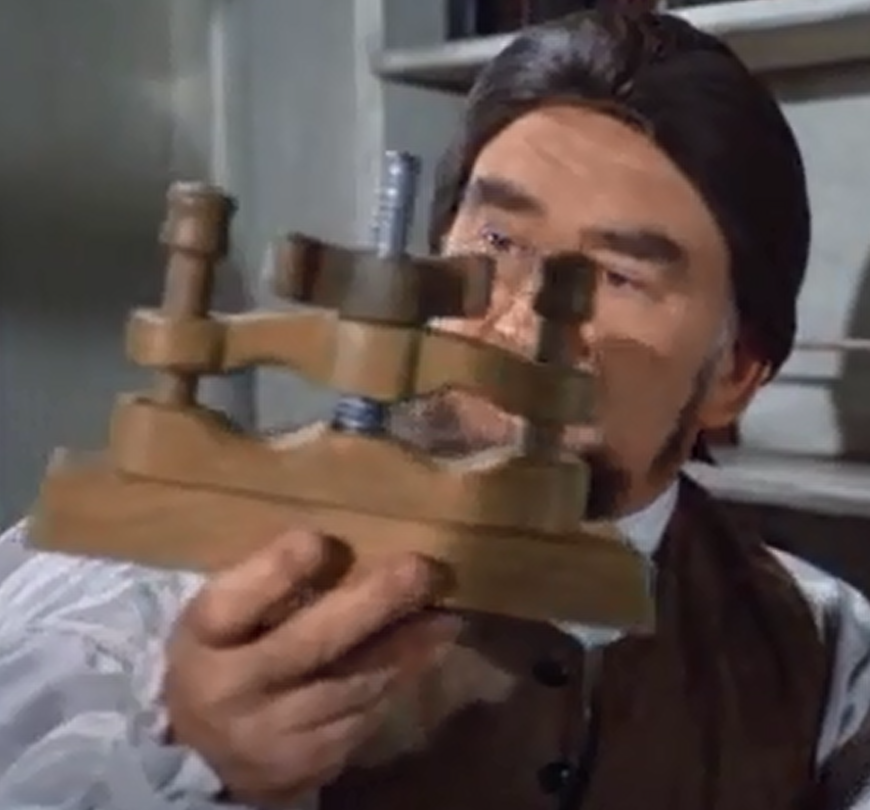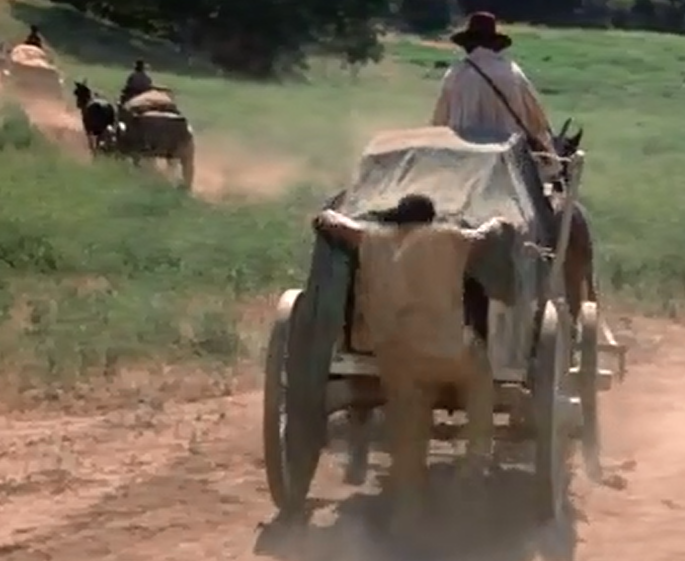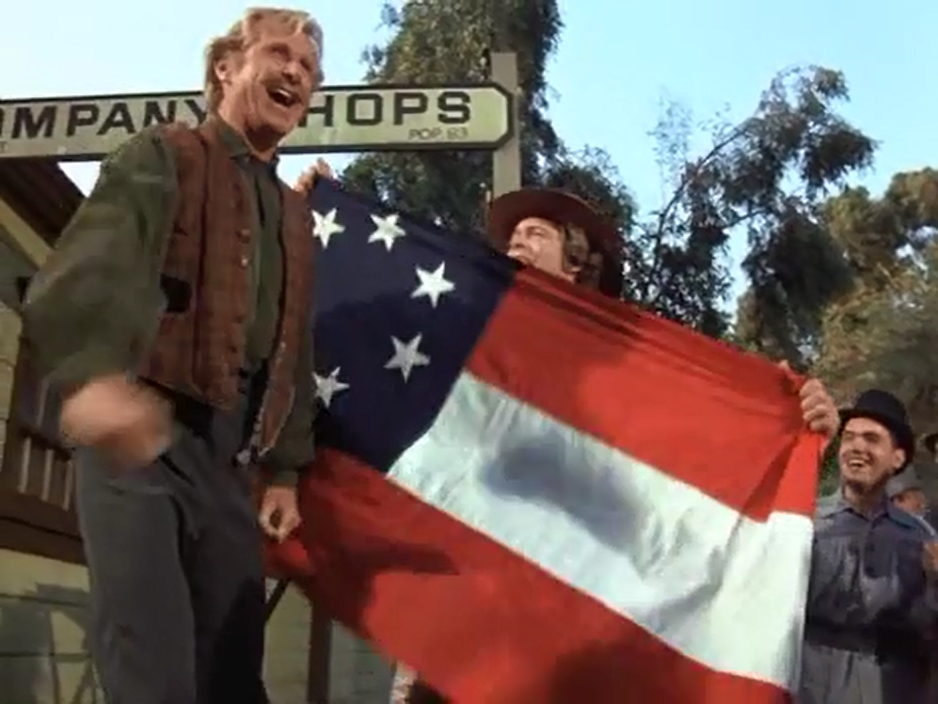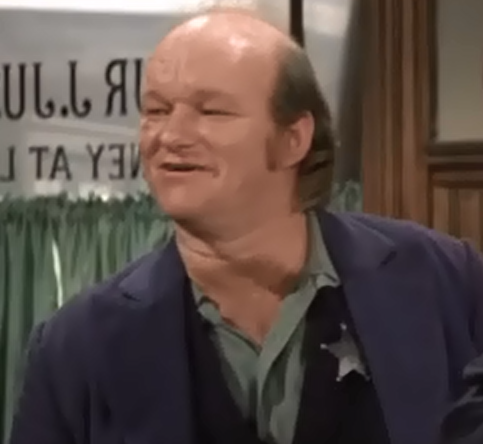Roots at 45
Posted By Beau Albrecht On In North American New Right | Comments DisabledRoots, the mother of the television miniseries, recently reached its 45th anniversary. It was based on Alex Haley’s book Roots: The Saga of an American Family. The story begins with Kunta Kinte, a young Mandinka tribesman from the Gambia who was captured and put on a slave ship bound for colonial America. It further covers his descendants and their tribulations, ending during the Radical Reconstruction.
All told, the acting is pretty decent for a TV program, featuring several existing and up-and-coming stars. LeVar Burton, who played the younger Kunta Kinte, does the haunted look just about as well as Nicolas Cage. His appearance began a long film career; later, he landed a starring role on Star Trek: The Next Generation. Other than that, Roots was sort of a black all-star feature presentation of its time. William Blinn, M. Charles Cohen, Ernest Kinoy, and James Lee adapted it for the screen. The directing magic was by Marvin M. Chomsky, John Erman, David Greene, and Gilbert Moses.
The series consists of eight episodes of two hours each (including commercials), and it first aired in January 1977. It remains one of the all-time most widely-watched TV programs. A large majority of Americans saw at least some of the episodes back in the day, including the liberal household of the future arch-deplorable, Yours Truly. There also was an unfortunate aftereffect, as the April 1977 issue of Instauration [2] describes:
The most immediate effect of this couthless, confabulatory chorale of anti-Caucasian contumely has been an uptick in Negro violence, a violence which is already accounting for perhaps 200 white deaths a month . . .
In some areas, the series aired at a later date. (I vaguely recollect a political kerfuffle about it, having to do with someone who had the balls to defy the network and delay it for as long as possible, much to the indignation of good liberal opinion.) It was edited down to six parts for rebroadcast by the BBC. Consequentially, some of the home video formats are in eight parts, and some six. More recently, in 2016, the History Channel produced a new version, following the Hollywood trend of cranking out unnecessary remakes.
The historicity question
The novel Roots was said to be derived from oral histories — in other words, stories passed down through the generations to Alex Haley. At the time of publication, it was presented as factual. However, it turns out that the book is fictional to a large degree [3]. When its claim to truthfulness became untenable, its author backtracked and described it as “faction.” He did drop some hints that he was consciously creating mythology. Other than that, it turns out that the native griot (storyteller) who corroborated Haley’s family history of Kunta Kinte didn’t have proper professional credentials to be a griot, and was simply telling him what he wanted to hear.
In that case, Roots belongs to a certain class of politically-charged literature, along with I, Rigoberta Menchú and the Anne Frank diary. That is, these are generally presented to the public as the honest truth, but are really inextricable mixtures of facts and imagination and are utilized to promote certain narratives and ideological agendas. To what degree the story is fake has been a matter of debate. For one example, a substantial amount of Roots’ source material was lifted from a novel called The African.
The African, which was fiction and never presented as otherwise, was authored by one of those famous Columbia University cultural anthropologists [4], Harold Courlander. Quite different from his Baltic Jewish origins, his specialties were Africana and American Indian culture. (Perhaps his initial interest in the region was spurred by the presence of a tiny colony that had briefly (from 1651 to 1664) existed on St. Andrew’s island in the Gambia River after being founded by his ancestral country. Kurland, which is now part of Latvia, thereby becoming the smallest and most obscure participant in the Scramble for Africa.) Courlander’s studies brought him to Haiti dozens of times, which was really taking one for the team [5]. It should be fair to say that The African was a product of his sympathetic perspective.
Because of Haley’s frequent textual borrowings, Courlander sued and settled out of court for $650,000. There’s been a lot of inflation since then, from the Carter Quarters days to the Bidet junta printing money like there’s no tomorrow, and that is the equivalent of about $2.8 million today. There must’ve been quite a lot of plagiarism to compromise on damages like that!
Moreover, there’s been a lot of difficulty corroborating the stories with any verifiable sources. In some cases, the book — and therefore the miniseries based on it — contradicts known facts. All told, much of the early family history is likely to be very imaginative. It’s entirely possible that Mr. Haley’s ancestors were treated a lot better than the endless litany of horrors in the story.
Episode 1
The story unfolds in Juffure, an idyllic settlement in West Africa. In the present day, it remains a small village [7], though with upgraded buildings. I haven’t seen the History Channel remake, but I suppose it might show gleaming skyscrapers and perhaps pyramid-shaped starships taking off from a distant spaceport. Things had been going so well before the honkies swept in there and stole all the Africans’ advanced technology, and then cast a magic spell to remove every last trace of it in order to make the natives forget how to make it, or that they ever even had it!
In the opening scene, Mrs. Kinte gives birth in one of the grass-thatched huts while Dad paces outside nervously. A Muslim sage enlightens the new father with some dry wit. Bare boobs are everywhere, which had never before been shown on a commercial TV program at the time, depicting preternatural innocence reminiscent of the Garden of Eden. Apparently they didn’t get the memo about ninja suits; are these the world’s most laid-back Muslims, or what? The boy grows up learning to herd goats, one of the industries meeting the sun-kissed community’s modest economic needs.
Thus, the folks in TV-land get to see what a paradise Africa was [8] before honkies came along and messed everything up with overpopulation, disease, tribal warfare, and kleptocratic dictatorships. However, there’s trouble on the horizon. In Maryland — back in the day when Americans were just limeys with attitude –, a shipping magnate offers an unemployed Captain a deal he can’t refuse. One day, he gives a very brief rundown about triangular trade. In their next scene, he’s discussing torture, the first of several places where the Captain appears quite glum
The Lord Ligonier, the slave ship said to have brought Kunta Kinte from the Gambia, did indeed exist. What the show doesn’t mention is that many of these operations were also based out of Rhode Island, firmly in Yankee-land. These ventures were quite often run [9] by those distantly related to the “fellow white people” who love to badger us about race relations lately.
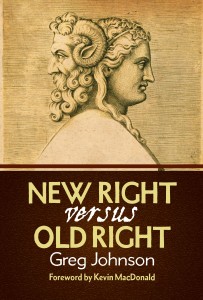 [10]
[10]You can buy Greg Johnson’s New Right vs. Old Right here [11]
Back in the bush, the adolescent boys are rounded up for their coming-of-age rites. (In Africa, they tended to be pretty hardcore about it, and I’d say they had a point with all that. Getting kicked into the club involved a lot more than fraternity hazing or getting a driver’s license.) Soon the drill instructor gives the youths the Sun-Tzu tactical rundown in the shade of the tall trees. After that, a big, bald wrestler owns them with aikido moves. Then Kunta Kinte is sent on a wild goose chase, and is outrun by O. J. Simpson after bumping into his daughter, Fanta. Yes, really!
Trouble is on the way. The Lord Ligonier has been crossing the ocean. Kunta Kinte spots some of the sailors leading a column of captives through the bush. He runs back to the drill instructor, who warns the rest of the youths to be on the lookout. Apparently this was the first ever toubob sighting in the area, which the book states explicitly. The Dahomeyans have never seen honkies before, yet already have a word for them.
Historical fact indicates that explorers, merchants, and missionaries had already been present in the region for a while. For that matter, Kurland had established its tiny island fort a few miles south of Juffure (called “Guilfere” on a Curonian map from 1651) a century before the protagonist’s birth. By the time of the story, the former Baltic trading post was in British hands and had been converted into a slaving depot, which the natives surely would’ve noted. The local chief didn’t object, provided that his own tribesmen weren’t sold. Lately it has been renamed Kunta Kinteh Island [12], a lasting testament to the effectiveness of publicity.
Just after graduating from boot camp, the young Mandinka is shanghaied, unfortunately having disregarded a couple of the Sarge’s safety tips. The historical truth is that native chiefs were exchanging enslaved prisoners of war and debtors very inexpensively for rum, beads, and trinkets, however. This was how business was normally done, and the African slave trade system was in use by natives and Arabs long before the Portuguese, Dutch, and British ever entered it. Abductions by sailors would’ve been very time-consuming and hazardous. Also, grabbing the wrong natives would’ve ruined relations with friendly tribes that were eager to do business. Roots helped create the popular misconception that slavery began with white sailors chasing down jungle bunnies with butterfly nets or the like.
Kunta Kinte is brought to a stockade with Fanta and the wrestler from boot camp, with a few of the dispirited Africans to ship out in the négrier. After being packed for several days in the cargo hold, the Middle Passage is especially dreadful. (Those who wish to get an accurate picture of this should consult the writings of Théophile Conneau. He didn’t hold back about this thoroughly nasty business, but neither did he exaggerate, as modern literature has a tendency to do, including Roots.) After getting a brief visit to the deck at long last, he realizes that they’ve left the Gambia River and are at sea.
Dispirited, he shows no interest in food after returning to the chamber of horrors below-decks. The wrestler persuades Kunta Kinte that warriors need nourishment. “Live and be strong. Be strong to kill the white man.” (That seems a little much for the 1970s, though agitation like that is old hat these days.) Right after that, the poor fellow next to him dies and gets chucked overboard. The young ladies in captivity are singled out for abuse, and the captain abominably fails a test of character. The episode ends with Kunta Kinte and the wrestler discussing a plot to take over the ship. One could hardly blame them.
Episode 2
Following some more outrage porn, the revolt on the Lord Ligonier begins. (Uprisings did occur occasionally; most successfully aboard the Amistad in 1839. There even was a Spielberg movie about it [14], which neglected to show that its hero, Cinque, became a slave trader after returning to Africa.) Despite a promising beginning, it’s suppressed quickly. Casualties include a major-league sociopath from the crew, the wrestler, and several others.
Finally, the négrier sails into Annapolis. Fanta and Kunta Kinte are the first to be sold. (I wonder, do auction sales still make blacks nervous?) He’s clearly not liking his new condition, and he doesn’t know any English. The master, played by Lorne Greene, appoints his overseer, Fiddler, to show him the ropes. This much is historically accurate, since slave overseers were often black, and sometimes were fellow slaves. What’s unsaid is that these class enemies were often quite sociopathic.
They arrive at the plantation in Virginia. He’s the only saltwater Negro (as the old term went); all the other slaves were born there and are assimilated to the African-American culture of the time. Gradually, he begins to learn English. Fiddler discourages him from trying to escape, telling him that there’s nowhere to go. Even so, he hopes to track down Fanta and manages to break the chain on his shackle.
The escape attempt goes badly, and he’s rounded up quickly. Kunta Kinte is assigned to the other overseer, a sadistic blond Irish guy. This leads to the iconic “Your name is Toby!” flogging scene.
Episodes 3 and 4 (US) / Episode 3 (UK)
Nine years later, in the watershed year of 1776, Kunta Kinte tries to make another run for it. This time he does meet with Fanta. She declines his offer to run away with him, however, considering it to involve deadly risk. She therefore prefers to accept her lot, which unfortunately is as a concubine. The slave catchers find Kunta Kinte and chop off half of his right foot after “mercifully” offering castration as an alternative. (The gruesome scene was the talk of my school the day after it aired.) The off-the-charts sadism was for dramatic effect. In real life, slave catchers would’ve been in deep shit for grievously injuring a captive they were supposed to be returning safely.
While recovering from his badly-infected foot, his master sells him along with Fiddler and some others. The new master is his brother, a doctor who’d been owed for a huge medical bill. Kunta Kinte falls in love with Bell, a high-placed domestic servant who pulls some strings and gets him a position as a driver. Only when he marries and becomes a father does he abandon his dream of running away. Instead, he determines that he’ll raise his daughter Kizzy to know her ancestral culture.
Episodes 5-6 (US) / Episode 4 (UK)
Sixteen years later, Kizzy is an eligible young lady. Her would-be boyfriend is Noah, who hopes to escape north and come back for her later. Kunta Kinte would’ve agreed with this in his younger days, but now warns him that running away would entail deadly danger.
Kizzy understands at least some of the Mandinka language, and she’s literate, too. The problem is that these are dangerous skills to have and could potentially get her sold down the river.
Historically, it’s true that there was a law in Virginia which prohibited slaves from being taught to read that was passed in 1832 following the deadly Nat Turner revolt the prior year. However, this part of the story happened long before, in 1806, so this plot point doesn’t work. (Louisiana, Mississippi, Alabama, Georgia, the Carolinas, and eventually Missouri also made it illegal to teach slaves to read, but it was legal to do so in other slave states. For some reason, The Narrative never clarifies this, pretending that the law was the same everywhere.) I haven’t researched the matter in great depth, but I find it doubtful that any slave would be punished for receiving illicit instruction long ago. One possible result of extra education might be a more favorable work assignment. Some plantations defied such laws, since they wanted house servants to be literate.
Missy Anne is the old friend who had taught her to read, and soon she’s coming to visit. Kizzy’s parents warn her that Missy Anne is probably on the way to growing up to be a typical honky. Even so, the reunion goes well.
More ominously, another guest is the conspicuously blond Mr. Moore, sent from the division of Central Casting specializing in rednecks with green teeth. He discusses the details of a recent failed slave uprising. (No such event happened at the time, but this was an anachronistic mashup of the Amistad and Nat Turner revolts. Again, these took place in the 1830s, not 1806.) He claims that increased tensions are motivating slave patrols to burn blacks and skin them alive. Yeah, sure . . .
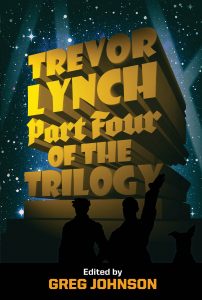 [17]
[17]You can buy Trevor Lynch’s Part Four of the Trilogy here. [18]
Noah runs away but is recaptured. He was caught with a forged travel permit, which Kizzy modeled after an original by Missy Anne. Noah and Kizzy are hauled away to be sold. Missy Anne doesn’t lift a finger to intervene, and what she says after that reveals her to be — you guessed it — a typical honky.
Kizzy gets sold to Mr. Moore, who turns out to be a sexual predator. (Kizzy’s former master is depicted as being somewhat enlightened, but sells her to him knowing that he’s a perp.) After the loathsome act, another character who’d been singled out for similar treatment tells her, “Massa Tom no different than most white men.” You can consider this to be a grotesque insult straight from the twisted minds of the screenwriters. I’ve covered this miserable topic [19] before and already said more than I care to say about it. That is, consensual affairs did occur occasionally, which by itself was quite dishonorable, but only an idiot would’ve resorted to coercion.
In the case of the fictional Master Tom, everybody knows what he does, including his wife, and he isn’t even shy about discussing his inclinations with people he’s just met. Every generation has its share of evildoers who secretly carry out utter infamy, but flaunting one’s depravity just didn’t fly back then. This completely misrepresents the character of the antebellum South, which was highly devout and strictly moral, and where reputations were crucial. (Even using profanity in front of a lady was next to unthinkable.) A perp who let it all hang out in real life would’ve stood a high likelihood of being murdered in his sleep one way or another, or his neighbors would’ve used him to stress test some rope at a necktie party. Anyway, this often-repeated theme in Roots is starting to smell like some kind of psychological problem in the writers.
She has a baby, who becomes the famous Chicken George, a sobriquet from his pursuit of cockfighting. (I’ll have to say that he does a pretty good acting job.) Kizzy has the opportunity to check up on her parents at long last. Her mother, as it turns out, was sold, and Kunta Kinte died in sorrow. What a fine bucket of tragedy.
Episodes 6-7 (US) / Episode 5 (UK)
Fast forward to 1841. Chickens, chickens, everywhere. Chicken George contemplates buying his way to freedom. Tensions rise with the Nat Turner rebellion which, again, really took place in 1831. (For Kek’s sake, how hard is it to do some basic research?) The uprising causes massive paranoia among the whites; but really, what’s the big deal? All they had to worry about is getting their throats cut at night. Chicken George is shot at by his mistress with a revolver that looks like it’s from the 1870s.
Although he’s been getting along pretty chummily with Master Tom, Kizzy warns her son never to trust a honky. The next thing that happens is that he shows up with a shotgun and threatens everyone in the cabin, including his kid. Kissy concludes, “No matter who they is, they all be toubob.” See how bad all these whites are? Then the dirty laundry about the thoroughly abominable family dynamics gets aired out.
Other than that, did I mention that there are a lot of chickens in this one? It basically turns into the cockfighting version of Ben Hur. (PETA wouldn’t like this part very much, of course.) Sadly, the plans to lead Panzerkampfgruppe Waffenchicken to victory go to naught. Master Tom sends him to Britain to work off the massive gambling debt. (In real life, Britain was a free soil country, so he could’ve done as he pleased after arriving.) Chicken George returns 14 years later, his kids now grown. Master Tom sets him free, finally honoring an agreement for once. He has to leave the state, however, because of some legal technicality that probably didn’t exist in real life.
Then the Civil War begins. A hick (who becomes quite troublesome later) joyously calls out, “Are we gonna whup them Yankees?” A crowd that can’t carry a tune in a bucket starts singing “Dixie.” More honky villainy continues up to the end of the show. There’s one exception: a white couple so downtrodden that they could’ve been Okies from The Grapes of Wrath. Finally, nearing the end of the saga, here are two decent honkies at last.
Episode 8 (US) / Episode 6 (UK)
General Lee surrenders and the Confederacy falls. All the slaves are free. Then comes the big question: What next? The blacks become sharecroppers. The whites, of course, conspire to screw them over so that they’ll never get ahead. (Point of historical fact: There were white sharecroppers, too, and life wasn’t buckets of fun for them, either.) In the alternate universe where Roots takes place, all violence during the Radical Reconstruction was white-on-black, and completely unprovoked as well.
A bunch of honkies come to the sharecropper village, whooping it up and setting fires. Chicken George’s son figures out who’s doing it and reports it to the local lawman. This, of course, is played by someone furnished by the division of Central Casting that specializes in Southern hog slop sheriffs. As one might expect, he tips off the number one hooligan. The mob returns again, this time wearing hoods made of flour sacks. (This suggests that these peckerwoods evolve into Fraternity Tri-Kappa.) Another iconic flogging scene occurs; revenge for dropping a dime on them.
When the situation is at its direst, Chicken George returns. He cleverly ties up the plot’s loose ends. Their main tormentor, when faced with the possibility of getting a taste of his own medicine, turns out to be a big pussy. The sharecroppers move to the greener pastures of Tennessee. I’ll have to credit the show for delivering a sensible message against retaliatory violence. Lately, such gestures have become out of step. This is especially so since George Floyd’s fentanyl overdose [22] ignited three months of rioting with The System’s tacit approval, while the mainstreammedia’s propaganda-peddling pukes encouraged the mayhem and made excuses for it.
My reaction
As a White Nationalist, I say that none of this should’ve happened, not even the true stuff. These unfortunate Africans should’ve been left alone in their sovereign territory. Everyone would’ve been better off. For our part, we could’ve skipped out on a Civil War, the Radical Reconstruction, trillions of dollars of wasteful social levelling programs, and much more. Even from a purely economic perspective, whatever was gained by a relative few cotton planters through slave labor was a bust several times over in other ways. Anyway, if I ever need a pick-me-upper, I can play the first episode backwards to see the woebegone Kunta Kinte and his colored Volksgenossen return to their happy tropical paradise where they belong.
On a positive note, one of the major themes (other than anti-white agitation, of course) is the importance of staying in touch with one’s heritage. That much is unobjectionable. This goes for whites, too. All too many of us are completely culturally bereft [23] these days.
Really, a little more along those lines would’ve all been well and good. Blacks do have a desire to rediscover their African roots, but that takes a lot of research, and the masses haven’t picked up the trail to their Urheimat yet. This is how they ended up with cringe ersatz culture like Kwanzaa [24]. Suppose they started giving themselves real names like Adewale, Kwame, or Eniola rather than some of the inventive monikers that have appeared since the 1960s? And surely they could find some better musical styles than nasty ol’ rap [25].
 [26]
[26]You can buy Greg Johnson’s It’s Okay to Be White here. [27]
Other than that, I’ll give Roots props for making a few points (or at least not airbrushing them out) that have been forgotten by The Narrative lately. For one thing, slavery was a problem inherited by the United States, not created by it. The show also briefly discusses the indentured servitude of whites; a topic that’s pretty much fallen into the memory hole. The slave quarters actually look pretty decent; perhaps at least that much is an upgrade from a hut with no protection against biting tsetse flies or other critters. More recent stories about slavery tend to lay it on thicker with the atrocity porn, leaving out anything that might be the least bit mitigating. The further we get from the actual historical events, the further The Narrative deviates from the truth. Still, the fact that Roots didn’t distort as much as it could have is pretty thin gruel to recommend eight episodes packed full of cultural Marxism.
Now for the not-so-good stuff. No matter what anyone can say for the acting, costuming, production, or whatever else, the bias was irredeemable. Of the black characters, they’re heroic and dignified, or at least tragically resigned to their fate. With only two noteworthy exceptions, the whites are severely compromised at the very best, and at worst deserve the gas chamber. (The blonds tend to be particularly horrible — gee, thanks.) Pray tell, what does such a skewed representation of racial character have to do with reality? This isn’t just from the source material; several screenwriters were responsible for putting this on TV exactly the way they wanted it.
Note well that none of my observations are to say that slavery was wonderful. The problem is that the distortions in Roots and similar propaganda are just a little much. The characterization of typical Southerners comes across unfavorably when compared to some of the more progressive figures in the Mongol Golden Horde, and that’s a pretty good sign that there’s something wrong with the picture. The distortions were deliberately put there to serve an anti-white agenda. The net effect was irritating century-old wounds, and this was done for a reason.
A tale about the tale
Given the provenance of Roots as an oral tradition — or so we’re told — it’s only fitting to relate another story passed down verbally which I’ll now make known to you, O my brothers. A former girlfriend told me that when her mother, of blessed memory, was working at a local hospital, the black and white nurses all got along on friendly terms. (Isn’t this the sort of multiracial harmony that liberals wish would blossom everywhere?) Then Roots was shown.
Following the miniseries, the friendliness ended. It was like an icy chill had come over the nursing department. Things were never the same again among these professional companions. After 16 hours of agitprop on the televitz, all that goodwill between the races was — to borrow an expression — gone with the wind.
* * *
Counter-Currents has extended special privileges to those who donate $120 or more per year.
- First, donor comments will appear immediately instead of waiting in a moderation queue. (People who abuse this privilege will lose it.)
- Second, donors will have immediate access to all Counter-Currents posts. Non-donors will find that one post a day, five posts a week will be behind a “paywall” and will be available to the general public after 30 days.
To get full access to all content behind the paywall, sign up here:
Paywall Gift Subscriptions
 [28]If you are already behind the paywall and want to share the benefits, Counter-Currents also offers paywall gift subscriptions. We need just five things from you:
[28]If you are already behind the paywall and want to share the benefits, Counter-Currents also offers paywall gift subscriptions. We need just five things from you:
- your payment
- the recipient’s name
- the recipient’s email address
- your name
- your email address
To register, just fill out this form and we will walk you through the payment and registration process. There are a number of different payment options.

